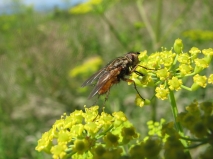Implications of enemy escape on chemically mediated interactions with mutualists: wild parsnip pollination in two hemispheres
DOI:
https://doi.org/10.26786/1920-7603(2013)6Abstract
When plant species invade new areas, they can escape from specialist enemies and thereby reduce investment in chemical defense. Enemy release may have other impacts on plant chemistry; in the absence of specialists, plants may be able to increase production of volatiles that enhance attractiveness to pollinators. In the United States (US), the introduced Eurasian wild parsnip, Pastinaca sativa, has long been subject to attack by an introduced coevolved florivore, Depressaria pastinacella, the parsnip webworm. In 2004, webworms were found for the first time attacking parsnips in New Zealand (NZ). Relative to US P. sativa, NZ P. sativa produces lower levels of defenses but higher levels of certain floral volatiles, suggesting that escape from its specialist florivore may have resulted in changes in volatile profiles to increase pollinator attraction.
In this study, we examined the influence of wild parsnip floral volatiles on pollinator attraction and seed production in NZ and the US. While many insect groups were observed on parsnip umbels, the percentage of flowers that set seed could significantly be predicted by the occurrence of large calyptrate flies and small syrphids in both localities. In the US, β-pinene, γ-terpinene, hexyl butyrate, octyl butyrate, germacrene D and an unknown monoterpene were all positively correlated with visitation by large calyptrates and small syrphids. In NZ, trans- ocimene, carene and octyl butyrate were positively correlated with visitation. Remarkably, most compounds positively associated with visitation are produced in significantly higher proportions in NZ flowers, suggesting that NZ flowers, in the absence of specialized florivores, may be chemically better constituted to attract pollinators.

Downloads
Published
How to Cite
Issue
Section
License
Copyright (c) 2014 Tania Jogesh, Arthur Zangerl, Margaret Stanley, May Berenbaum

This work is licensed under a Creative Commons Attribution 4.0 International License.
JPE is an open access journal which means that all content is freely available without charge to the user or his/her institution.
Authors who publish with this journal agree to the following terms:
1) Authors retain copyright and grant the journal right of first publication with the work simultaneously licensed under a Creative Commons Attribution License that allows others to share the work with an acknowledgement of the work's authorship and initial publication in this journal.
2) Authors are able to enter into separate, additional contractual arrangements for the non-exclusive distribution of the journal's published version of the work (e.g., post it to an institutional repository or publish it in a book), with an acknowledgement of its initial publication in this journal.
3) Authors are permitted and encouraged to post their work online (e.g., in institutional repositories or on their website) prior to and during the submission process, as it can lead to productive exchanges, as well as earlier and greater citation of published work (See The Effect of Open Access).
To assure a broader targeted audience, content will be included into databases (such as EBSCO) and directories (such as DOAJ).











